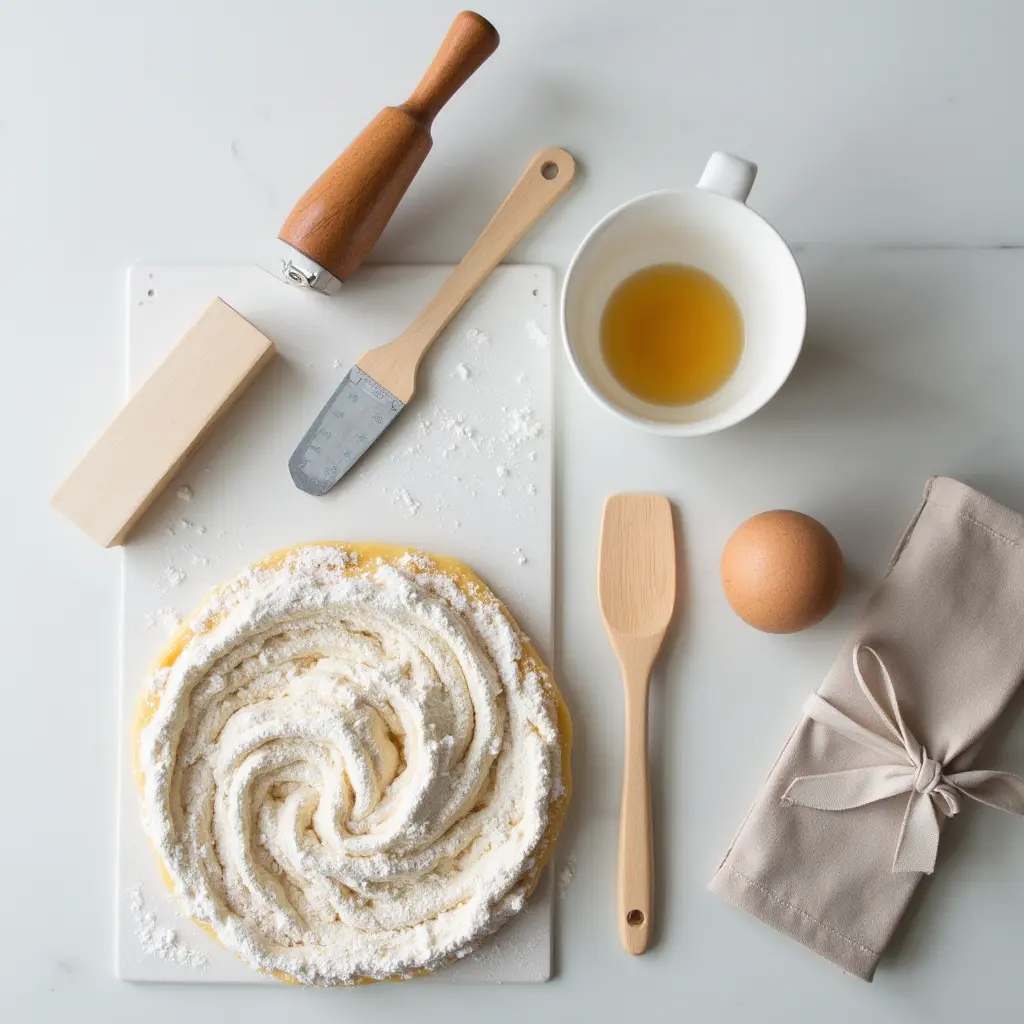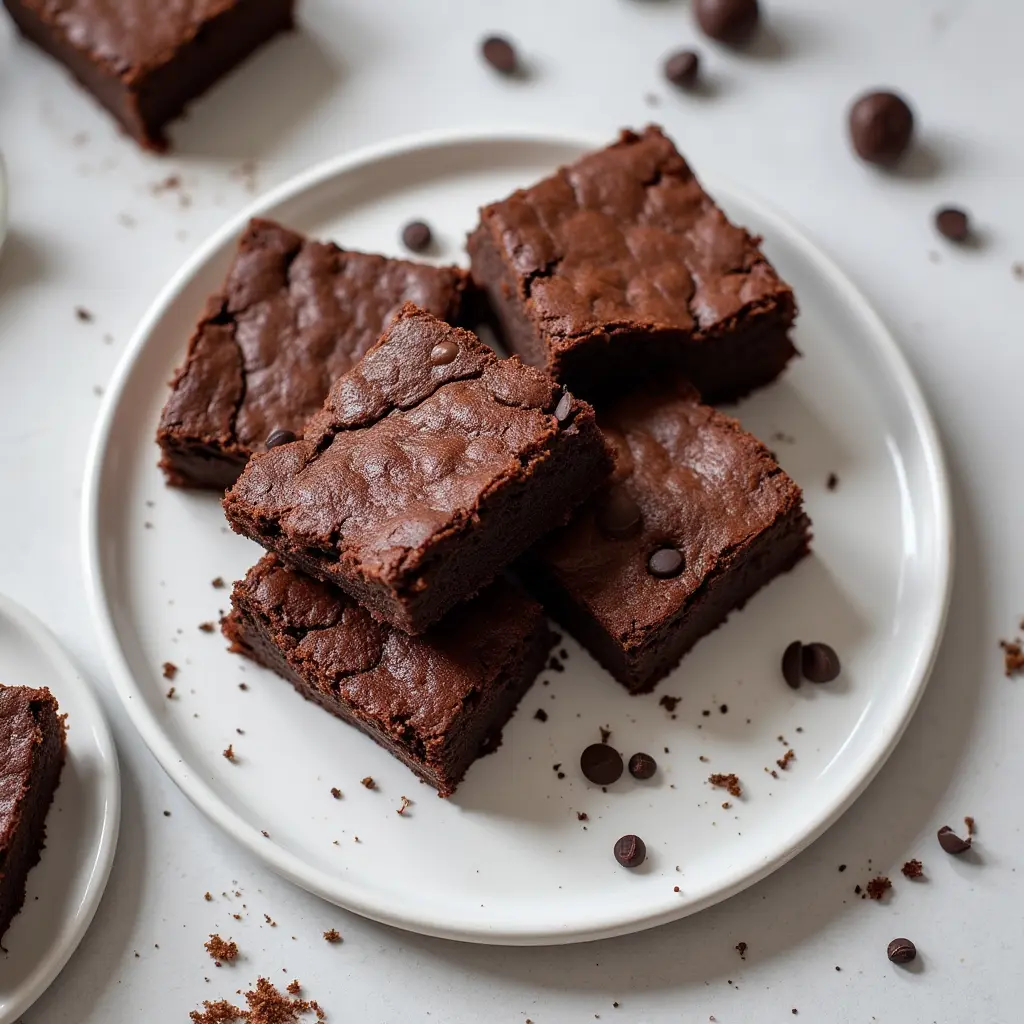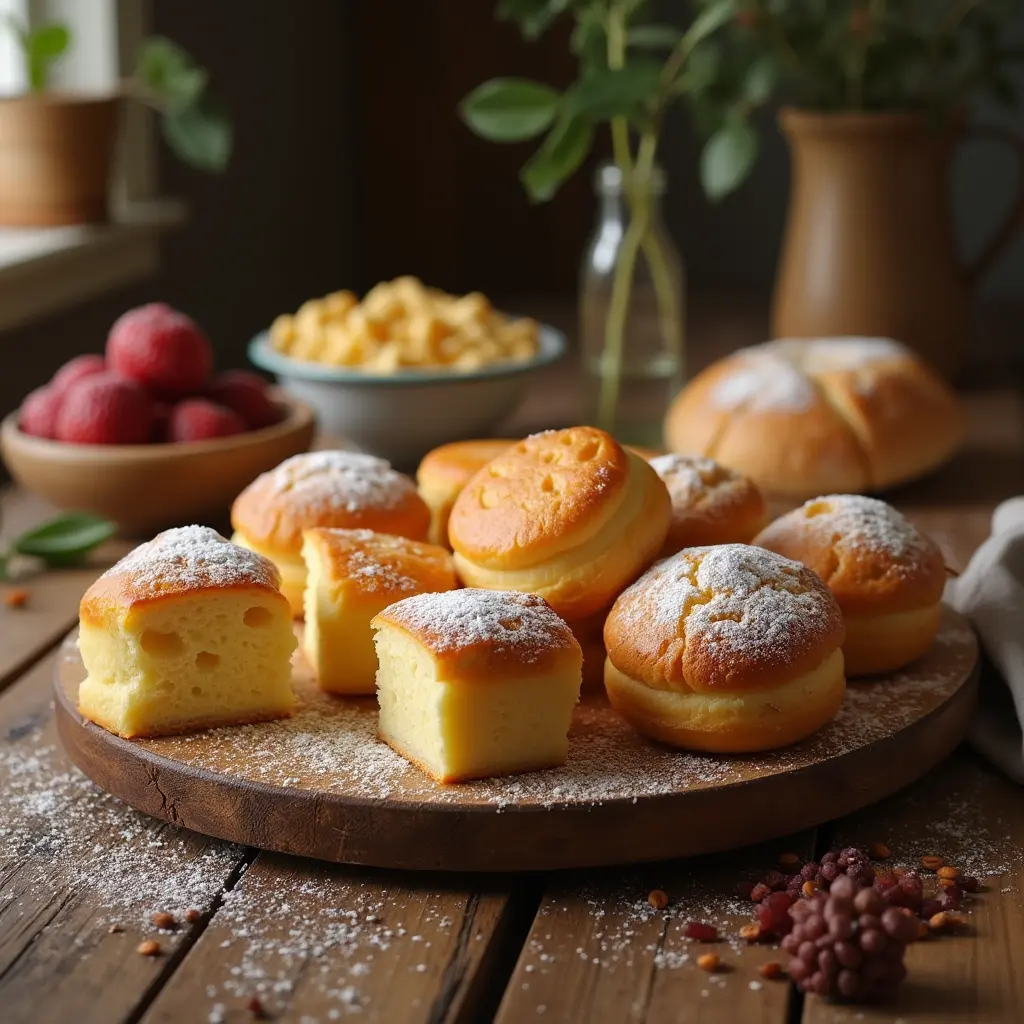Explore simple sourdough dessert recipes that blend tang, sweetness, and rich flavors, perfect for any baker seeking unique, delightful treats.
Introduction to Sourdough Desserts
Sourdough Desserts
Simple sourdough dessert recipes are transforming the world of sweet treats. Although sourdough once defined basic breads, it now inspires creative confections. Albeit traditional uses skew savory, bakers now embrace its unique tang in desserts. Comparatively, sourdough desserts taste more complex than their yeast-based counterparts. They deliver subtle acidity and distinct depth, providing a memorable flavor profile. Accordingly, more home cooks seek to master this art.
Another reason for sourdough’s popularity lies in its versatility. You can use your existing starter to craft countless treats. Although it might seem tricky, sourdough provides an exciting baking challenge. If you want to learn more about sourdough starters, check out King Arthur Baking’s Sourdough Starter Guide for expert advice. Additionally, if you’re curious about the science behind fermentation, Serious Eats fermentation primer offers valuable insights. Furthermore, if you want general baking guidance, Food52 baking tips can help you refine techniques.
In the ensuing segment, we will explore the benefits of baking with sourdough and understand why it outshines regular dough. Before diving into specific recipes, let’s see how sourdough’s character improves the sweetness and texture of desserts.
Benefits of Baking with Sourdough
Sourdough’s acidity helps break down grains, making treats easier to digest. Comparatively, it often leads to a lower glycemic index, helping reduce sugar spikes. Moreover, it adds a natural preservative effect. Consequently, your desserts stay fresher for longer. In the next subsection, we’ll look closer at the science behind sourdough and its fermentation magic.
The Science Behind Sourdough
Sourdough involves wild yeast and bacteria, chiefly lactobacilli. Specifically, these microorganisms ferment flour and water, producing carbon dioxide that leavens dough. This slow process builds complex flavors. Instead of a one-note sweetness, sourdough desserts deliver layers of taste, from subtle tang to gentle sweetness.
Because of these microorganisms, the dough ferments slowly. Eventually, this allows gluten to develop without excessive kneading. Notwithstanding the extra steps, the result is worth it. You get a tender crumb, moist texture, and a unique aroma. In the next phase, we will discuss the essential tools you need to begin crafting your own sourdough desserts.
Tools You Need for Sourdough Baking

Before starting with simple sourdough dessert recipes, gather some basic tools. You’ll need a mixing bowl, a sturdy whisk, and a reliable wooden spoon. A kitchen scale ensures accuracy, since sourdough demands precise measurements. Furthermore, a bench scraper helps handle sticky dough. A proofing basket aids in shaping dough, albeit it’s optional for many dessert recipes.
Also, consider an oven thermometer. Sourdough desserts need consistent temperatures. Likewise, baking parchment and silicone mats prevent sticking. These small investments improve your baking experience. In the subsequent chapter, we’ll move from tools to understanding and maintaining a sourdough starter specifically suited for desserts.
Mastering Sourdough Starter for Desserts
Your sourdough starter is the heart of every recipe. Keep it healthy and active. Initially, feed it equal parts flour and water until it bubbles happily. Eventually, you’ll notice it doubles in size. This lively starter imparts complexity and aroma.
When using it in desserts, adjust feeding schedules to build sweetness. Simultaneously, experiment with different flours. For instance, whole wheat or rye can add earthiness. However, consider white flour for a milder taste in sweet treats. In the following segment, we’ll talk about the key ingredients and how to choose them wisely.
Choosing Ingredients for Sourdough Desserts
Selecting quality ingredients matters. Surely, use high-quality flour with consistent protein levels. Opt for fresh butter and eggs from reputable sources. Similarly, pick organic sweeteners whenever possible, and ensure your starter is vigorous. Fresh fruits, chocolate, and spices elevate flavors. Use real vanilla extract for a fragrant aroma. In the next installment, we’ll consider how sourdough’s tang contrasts with both sweet and savory profiles.
Sweet vs. Savory Sourdough Baking
Traditionally, sourdough aligns with savory bread. However, adapting it into desserts introduces a new dimension. The slight tang balances heavy sweetness. Also, sourdough pairs nicely with fruits, nuts, and chocolate. In the ensuing segment, we’ll explore recipes suitable for beginners who want to start their journey with simple sourdough dessert recipes.
Sourdough Recipes for Beginners
Start simple. Consider sourdough pancakes or waffles for a sweet brunch. Add chocolate chips or fresh berries. Comparatively, these entry-level recipes demand less fermentation time. They still deliver unique flavors and textures, giving novices confidence. For those interested in other sweet treats, consider checking our website’s chicken-salad-chick-grape-salad-recipe-sweet-treat for inspiration on sweet fruit-based dishes. In the next section, we’ll tackle advanced recipes that challenge and delight experienced bakers.
Advanced Sourdough Dessert Recipes
Once comfortable with the basics, try elaborate pastries. For example, sourdough croissants or brioche-based desserts test your skills. Additionally, consider complex cakes that rely on extended fermentation. In the subsequent portion, we’ll discuss tips to achieve perfect results every time.
Tips for Perfect Sourdough Baking Every Time
Keep notes. Track feeding schedules, ambient temperatures, and ingredient brands. Likewise, adjust hydration levels if your dough feels too sticky. Ensure proper proofing times. Furthermore, learn to shape and score dough for consistent rises. With practice, your simple sourdough dessert recipes will improve. Advancing to the next topic, let’s explore popular sourdough dessert recipes you can try at home.
Popular Sourdough Dessert Recipes
Sourdough Sticky Buns
Sticky buns are a classic. Essentially, the sourdough version adds tangy complexity. The dough ferments overnight, creating a tender crumb. The filling blends butter, sugar, and cinnamon. After baking, the caramelized topping oozes down the sides. Notwithstanding the effort, these buns surpass regular sticky buns in flavor and texture. In the next division, we’ll look at autumn-inspired pumpkin cinnamon rolls.
Sourdough Pumpkin Cinnamon Rolls
Autumn flavors shine in these rolls. Basically, sourdough starter combines with pumpkin puree, cinnamon, nutmeg, and cloves. The dough rises slowly, absorbing warming spices. Afterward, top with chai-spiced cream cheese frosting. The subtle tang from the starter enhances pumpkin’s sweetness. Proceeding to the next chapter, we’ll explore sourdough pecan cookies.
Sourdough Pecan Cookies
These cookies are nutty, buttery, and slightly tangy. Comparatively, sourdough adds chewiness and depth. Mix active starter with butter, sugar, and chopped pecans. Roll dough into small balls and bake until crisp edges form. Serve with milk or coffee. Continuing in the following part, discover a comforting sourdough apple crisp.
Sourdough Apple Crisp
This dessert pairs tart apples with a tangy sourdough crumble. Evidently, sourdough discard combines with oats, cinnamon, and brown sugar. Sprinkle over sliced apples and bake. The result is a warm, comforting treat perfect for fall evenings. In the next subsection, we’ll learn how to make sourdough chocolate chip cookies.
Sourdough Chocolate Chip Cookies
Sourdough chocolate chip cookies offer complex flavor. The tang from the starter balances sweet chocolate. Equally, the extended fermentation improves texture, creating chewy, flavorful cookies. Chill the dough overnight. Bake until edges are golden. In the ensuing segment, we’ll address sourdough snickerdoodle cookies.
Sourdough Snickerdoodle Cookies
Snickerdoodles rely on cream of tartar for tang. However, sourdough provides a natural tang that enhances flavor. Roll the dough in cinnamon sugar and bake. The result is a soft cookie with a crisp exterior and subtle sour note. In the next phase, discover fudgy sourdough brownies.
Sourdough Brownies

Rich chocolate brownies gain complexity from sourdough. Similarly, the starter’s acidity enhances chocolate flavor. The result is moist, dense brownies with a luscious crumb. Slice and serve warm. In the following segment, we’ll explore sourdough lemon cake.
Sourdough Lemon Cake
Lemon’s brightness pairs well with sourdough’s tang. Hence, sourdough lemon cake tastes lighter and more aromatic. Add lemon zest and juice to the batter. Drizzle with a simple lemon glaze. In the next installment, let’s examine sourdough pumpkin muffins.
Sourdough Pumpkin Muffins
Moist and tender, these muffins combine pumpkin puree and sourdough. Surely, they taste like autumn. Add cinnamon, ginger, and cloves. Top with pepitas for crunch. Enjoy with coffee or tea. In the succeeding section, we’ll try a refreshing summer dessert—sourdough strawberry shortcake.
Sourdough Strawberry Shortcake
A tangy sourdough biscuit pairs beautifully with sweet strawberries. Thereafter, top with whipped cream. The acidity brightens the fruit’s flavor. This dessert feels light and fresh, a perfect summertime treat. On to the following discussion, we’ll examine specialty sourdough dessert variations.
Specialty Sourdough Dessert Variations
Gluten-Free Sourdough Desserts
Gluten-free sourdough uses alternative flours like buckwheat or millet. Instead, you rely on gluten-free starters. These desserts still deliver complex flavors. Additionally, careful handling ensures proper fermentation. Heading into the subsequent area, we’ll discuss vegan sourdough desserts.
Vegan Sourdough Desserts
Vegan bakers can still enjoy simple sourdough dessert recipes. Replace butter with coconut oil and eggs with flax “eggs.” Comparatively, the tangy flavor remains intact. Add plant-based milk and sweeteners. In the next subsection, we’ll highlight holiday-themed sourdough treats.
Sourdough Desserts for Holidays
For festive times, bake sourdough gingerbread cookies. Evidently, they burst with spice and aroma. Or craft sourdough sugar cookies, decorating them with icing. For a unique twist, try sourdough fruitcake with dried fruits and nuts. Moving forward to the next topic, let’s consider sourdough desserts for kids.
Sourdough Desserts for Kids
Kids love treats like sourdough oatmeal cream pies. Obviously, these are softer and tangier than store-bought versions. Add chocolate chips or sprinkles. Children appreciate the novelty of sourdough’s mild tang. Transitioning into the following chapter, we’ll explore international sourdough desserts.
International Sourdough Desserts
Many cultures use fermented dough in desserts. For example, Mexican conchas or sweet buns benefit from sourdough starters. Dutch baby pancakes, originally from Europe, gain complexity from sourdough. This global inspiration expands your dessert repertoire. In the next division, we’ll focus on healthier sourdough desserts.
Healthier Sourdough Dessert Options
Reduce sugar and add whole grains for healthier treats. Similarly, incorporate fruits or nuts for nutrients. Sourdough’s natural acidity aids digestion. The result is desserts that feel indulgent but are gentler on the body. In the next phase, we’ll consider no-bake sourdough desserts.
No-Bake Sourdough Desserts
Use sourdough discard in cheesecake crusts. Thus, you get a tangy base for creamy fillings. Press the mixture into a pan and chill. Add fruit curd or chocolate mousse on top. No-bake treats still benefit from sourdough’s complexity. In the ensuing segment, we’ll suggest drinks to pair with sourdough desserts.
Pairing Sourdough Desserts with Drinks
Tea, coffee, and even sparkling wine complement sourdough desserts. For instance, the simple sourdough dessert recipes like brownies pair well with espresso. Lighter treats, like strawberry shortcake, match green tea. For unique beverage ideas, consider pairing your dessert with a refreshing green tea shot. In the next installment, we’ll inspire you to experiment with unusual sourdough dessert flavors.
Creative Sourdough Dessert Experiments
Try sourdough tahini cookies or black-and-white sourdough cookies. Emphatically, encourage creativity. Adjust spices, sweeteners, and mix-ins. Don’t fear uncommon flavors. In the next subsection, we’ll review how to store and freeze sourdough desserts.
Storing and Freezing Sourdough Desserts
Store sourdough desserts in airtight containers. Additionally, many freeze well. Slice brownies before freezing for easy portioning. Let cakes cool fully before wrapping. This preserves moisture and flavor. In the next subsection, we’ll move to FAQs to address common questions.
FAQs and Final Thoughts
Is sourdough good for desserts?
Altogether, yes. Sourdough introduces complexity, tanginess, and improved texture. Nevertheless, desserts remain sweet and inviting. The tang enhances flavors, making them memorable.
What not to do with sourdough?
Do not rush fermentation. Undoubtedly, patience matters. Avoid adding too much sugar, which can overpower delicate flavors. Do not neglect feeding your starter.
Why must you discard sourdough starter?
Discarding prevents starter from growing too large or weak. Basically, it maintains a healthy balance of yeast and bacteria. Without discarding, your starter can become overly acidic or stale.
Why is sourdough a healthier option?
Sourdough’s fermentation breaks down complex sugars. Hence, this reduces spikes in blood sugar. It also improves nutrient availability and eases digestion. Doubtedly, sourdough treats can be more gut-friendly.
Internal Linking Opportunities:
For those who love unique sweets, consider exploring our coconut cake vape recipe for another creative treat. If you seek savory-to-sweet transitions, review our lemon garlic shrimp pasta to understand contrasting flavor profiles.
In conclusion, simple sourdough dessert recipes transform ordinary sweets into extraordinary indulgences. Although sourdough may seem complicated at first, practice leads to mastery. Enjoy experimenting with flavors, exploring global influences, and catering to dietary needs. Sourdough desserts are worth the effort. Keep innovating and delight in the tangy, sweet world you’ve created.
